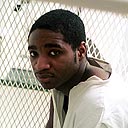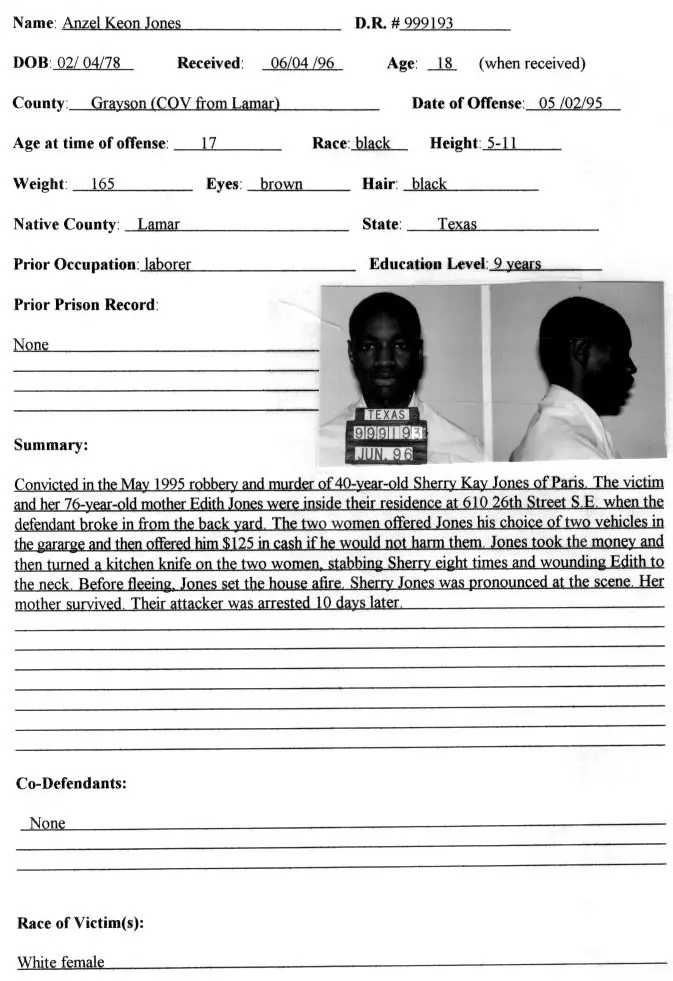A Killer Called 'Youngster'
Miriam Rozen - Law.com
March 24, 2004
At age 17, Anzel Keon Jones, a high school
sophomore, played football, ran track, partied on weekends --
and murdered a woman and sexually assaulted her mother.
Jones, whose nickname among his fellow death
row inmates is Youngster, doesn't deny his actions. "I did it,"
he says.
Now, nine years later, Jones and his lawyer
hope the U.S. Supreme Court will decide in Donald P. Roper,
Superintendent, Potosi Correctional Centers v. Christopher
Simmons -- a Missouri case -- that executing those who
committed crimes while under the age of 18 is unconstitutional.
But J. Kerye Ashmore, an assistant district
attorney in Grayson County who prosecuted Jones, unequivocally
doesn't want the Texas death row inmate's sentence changed to
life in prison.
"I don't think the jury had much problem with
their decision, and they knew his age," says Ashmore about Jones.
On Feb. 25, U.S. Supreme Court Justice
Antonin Scalia stayed Jones' execution -- which had been slated
for April 29 -- pending the outcome of Simmons.
In Stanford v. Kentucky (1989), the
high court set 16 as the minimum age for imposing the death
penalty. But on Jan. 26, it granted certiorari in Simmons,
and may once again consider at what age a criminal can be
sentenced to death. Christopher Simmons' lawyers at the Missouri
Supreme Court, and Jones' lawyer Richard Burr, in his petition
to the U.S. Supreme Court, have argued that the U.S.
Constitution's 8th Amendment forbids as cruel and unusual
punishment executing individuals who were under 18 at the time
they committed the crimes for which they are sentenced to die.
Jones isn't alone in getting a stay. He is
one of 27 Texas death row inmates who were under 18 at the time
they committed crimes. At the beginning of February, five of
Texas' death row inmates had execution dates. But by the end of
the month, the U.S. Supreme Court had granted stays in Jones'
and another inmate's cases, pending the outcome of Simmons.
Harris County Assistant District Attorney
Jane Scott says her office has filed motions to withdraw pending
execution dates in two of the other cases in which Texas death
row inmates were convicted of crimes committed under the age of
18. Scott says, "It became obvious that we would be pursuing
execution dates that would be stayed because of Simmons."
The fifth Texas death row inmate who was
under 18 at the time of his crime has a June 29 execution date.
Mauro Morris Barraza's lawyer -- Scott Schutte, a partner in
Chicago's Jenner & Block who is working on the case pro bono --
says he will file a motion in Tarrant County District Court
within the next month seeking a stay of his client's execution
pending the outcome of Simmons.
Eventually, Burr says he expects all 27 Texas
death row inmates who were under 18 at the time of their crimes
to seek stays.
"The stays were granted by Justice Scalia ...
so it reflects a policy decision on the part of the court," says
Burr, a partner in Houston's Burr & Welch. While Simmons
is pending, "no juvenile case is going through [nationwide]," he
says.
Burr and five other defense lawyers who
represent death row inmates argue that since the U.S. Supreme
Court ruled in Stanford in 1989, attitudes have evolved
in the United States, making the death penalty for individuals
who committed crimes under age 18 cruel and unusual.
Specifically, they note that 31 states --
most recently South Dakota and Wyoming -- have enacted
legislation barring the execution of inmates who were under age
18 when they committed their crimes. They believe that juries in
states such as Texas, where 17-year-olds are eligible for
capital punishment, have begun to shy away from such sentences.
Burr wrote in Jones' petition for writ of
certiorari filed with the Supreme Court that in 2003, of the
seven cases nationwide tried in which the death penalty was a
possible sentence for a defendant 17 or younger, juries returned
only one death sentence.
Six states, Burr wrote, have executed inmates
who committed their crimes under the age of 18 since 1989. Since
1998, Texas has executed eight inmates, the most nationwide, who
committed their crimes under the age of 18.
Veteran death row defense lawyers such as
Burr are optimistic that Simmons will stop the executions
of inmates who committed their crimes at age 16 or 17. Their
optimism is pinned largely on Atkins v. Virginia, a 2002
opinion in which the U.S. Supreme Court said executing mentally
retarded criminals violated the Eighth Amendment.
In Atkins, the court wrote that the "large
number of States prohibiting the execution of mentally retarded
persons [showed] that today our society views mentally retarded
offenders as categorically less culpable than the average
criminal."
In Jones' cert petition, Burr, citing the
medical opinion of neuropsychologist and University of
Pennsylvania professor Dr. Ruben C. Gur, wrote that individuals
under the age of 18 are not as culpable as those who commit
crimes when they're older.
In a declaration Burr included with Jones'
writ, Gur stated that medical evidence shows that 16- and 17-year-olds
don't have the same ability to control impulse behavior as
adults. Gur attributed the lapses in part to the uncompleted
processes of fat tissue growing around brain paths used for
information exchange. Researchers at the Harvard Medical School
and the National Institute of Mental Health have conducted long-term
measuring studies of the brain and showed that frontal lobes
undergo significant changes between ages 12 to 22.
Gur wrote, "My opinion is that the human
brain is not fully mature before reaching adulthood, and that
furthermore the brain regions that are most important for
regulating impulse control, planning, consideration of
consequences, abstract reasoning and, most probably, moral
judgment are the very regions that mature last."
MITIGATING FACTOR?
Not surprisingly, many Texas prosecutors and
judges sharply disagree with the conclusions of some death row
inmates' lawyers. Some do not want to await the outcome of
Simmons before going forward with the executions of Texas
inmates who committed their crimes under age 18.
Chuck Mallin, an assistant district attorney
in Tarrant County in the appellate division, rejects the
constitutional arguments made by defense lawyers for death row
inmates who committed their crimes under the age of 18. For
starters, he doesn't believe that state legislative action
accurately indicates the country's attitudes. "I don't buy that
legislatures reflect the views of their constituents. I don't
think it's a true reading."
He doesn't think it's appropriate to draw
comparisons between the disabilities of a mentally retarded
person and any found in a 17-year-old. "It's a harder
distinction to make," Mallin says about 17-year-old brain
development versus that of adults. "At 17, you can comprehend
what you are doing."
He also notes that Texas juries have the
option to consider age as a mitigating factor in each capital
case put before them.
Victor Streib, a professor at Claude W.
Pettit College of Law at Ohio Northern University who has
written extensively about death row inmates who committed their
crimes under the age of 18, says the Supreme Court could take
several tacks in Simmons. The justices could rule
strictly on the issue of whether the Missouri Supreme Court had
the authority to disregard Stanford when it decided that
it would be cruel and unusual punishment to execute Simmons
since he was under 18 when he committed his crime. If the
Supreme Court rules only on that issue, Streib says, it doesn't
have to address the constitutionality of executing 16- and 17-year-olds.
But Streib says if the high court does rule
in favor of Simmons, who was convicted of murdering a 46-year-old
woman after an invasion of her home, its ruling will
unquestionably impact all states that now allow executions of
inmates who committed their crimes under age 18. Why? Because
Simmons asks directly whether it is constitutional to
execute 16- and 17-year-olds. So if the court rules in Simmons'
favor, states that define 16- and 17-year-olds as adults would
be violating the Constitution if they executed them, Streib says.
David Dow, a criminal law professor at the
University of Houston Law Center, says: "There is a very
plausible reason to think the court is going to do in the
juvenile area exactly what it did with mental retardation."
Ashmore, who prosecuted Jones in 1995 in
Lamar County, agrees that the Supreme Court ruling in Simmons
could alter how the death penalty is assessed in Texas. But
Ashmore isn't willing to speculate further. "I'm not good enough
to evaluate and analyze an opinion before it's issued," says
Ashmore, now an assistant district attorney in Grayson County.
There is no question, however, about what
Ashmore believes should happen in Jones' case.
"This is what I can tell you about Anzel Keon
Jones. He went into a backyard, took a nearly 50-year-old woman
and beat her with a gun, cut her throat in front of her mother,
then sexually assaulted her mother in every way imaginable,
including perforating her organ with an antenna, cut her throat,
attempted to burn the house down and fled. He doesn't deserve to
be in society ever again. He needs to be executed. Twelve people
heard the evidence, including his age, and didn't feel that it
mitigated his crime," Ashmore says. The surviving victim of
Jones' crimes, Edith Jones (no relation), died several years
ago, the prosecutor says. Her son has asked not to be contacted
by reporters, Ashmore says.
Defense lawyer Burr says that emotionally
Anzel Jones is not the same individual convicted of capital
murder. "He is very different from the impudent, arrogant, 17-year-old
tried for capital murder. Trial lawyers had a difficult time
with him because he acted out, but he is a delightful adult now,"
Burr says.
NO EXPLANATION
In an interview at the Texas Department of
Criminal Justice prison in Livingston, Jones appears startlingly
good-natured, congenial and articulate.
"I'm sort of a people person," he says.
At the time of his arrest, Jones not only
played receiver and running back on the North Lamar High School
football team, but also competed in hurdles, sprint relays and
the high jump for the track team. His grades at the Paris high
school were mediocre. "I was an A, B, C, D student," Jones says.
Jones lived in a middle-income neighborhood with his mother and
sister. About his father, Jones says, "Me and him, we don't
associate no more."
Jones' grandmother, 65-year-old Betty Jones,
says she never knew the boy's father.
Betty Jones and Garland Cardwell, a partner
in Sherman's Munson, Munson, Cardwell & Keese who was Anzel
Jones' defense lawyer at trial, say Jones never had been in
serious trouble before the early morning hours of May 2, 1995,
when he went to the home of Sherry Kay Jones and her mother,
Edith, two women who lived across the street and whom the high
school student knew only casually.
About a year earlier, Jones had appeared
before a judge in juvenile court for stealing cigarettes with a
friend, Cardwell says. "We stuffed them down our pants and got
caught," Jones says. But he performed the community service the
juvenile court judge required. "The only thing then was going to
school, acting up on weekends, drinking, riding around, and
playing football. That was my mentality," Jones says.
On Burr's advice, Jones declines to answer
questions involving details of his crimes. Asked for an
explanation of why he committed such heinous acts, Jones
provides no clues. "I sit back nights, actually years, and I
just can't think of anything," Jones says.
At the crime scene, Ashmore and Cardwell say,
police found cult-related signs scrawled in the dirt in the
backyard. Cardwell says he always suspected that other teenagers
had put Jones up to the murders as part of some cult initiation
rite, but Cardwell never developed that evidence. Jones insists
he acted alone, Cardwell says.
Police arrested Jones at school a few days
after he committed the crimes. Cardwell and Ashmore say Jones'
fingerprints were found on a bottle of nail polish remover that
had been thrown under a chair in the women's home. Its contents
had been poured around the perimeter of the house as fuel to
burn it.
Jones says his arrest and the threat of
prison didn't worry him at the time. "I didn't even take it
seriously. I didn't take nothing seriously back then," he says.
"Back then I was sort of like, 'Fuck the world.' "
Jones pleaded not guilty. Cardwell says his
client could be charming at one moment, and unruly the next.
Jones acted up in the jail and before the judge, Cardwell says.
In court, Cardwell remembers, Jones made gang-sign gestures to
friends in the courtroom and drew pictures of the judge in Ku
Klux Klan costumes. "Every time I turned around, he was doing
something I told him not to," Cardwell says.
Betty Jones also believes her grandson didn't
help his case. "He just sat there," she says.
At trial, Cardwell called only the
grandmother to the stand. He did not call Jones' mother, sister
or the defendant himself. "I didn't think he'd hold up under the
prosecutors," Cardwell says. "He never really showed any remorse."
The evidence presented at trial and the
testimony of Edith Jones was paralyzingly graphic, Cardwell says.
After the prosecutor displayed pictures of the crime scene,
Cardwell remembers, one juror became physically ill and had to
be replaced.
The true weight of his sentence, Anzel Jones
says, didn't dawn on him until he was 19, two years after he
arrived on death row. He recalls he was assigned to cleaning
duty and was scrubbing in an area occupied by an inmate whose
execution was scheduled for the next day. Jones knew the inmate
as Poppa. "He was the first cat I knew that got executed," Jones
says. "I got a chance to talk to him about being on death row.
He just got a letter from his daughter, but the mailroom had
held it until the day before his execution. He never did open it.
That's when I understood what I'm facing now."
As soon as judges set an execution date for a
death row inmate, TDCJ spokeswoman Michelle Lyons says, prison
officials segregate those individuals in a separate unit. Jones
has resided on that unit, known as the Deathwatch Pod, twice
because he had an execution date scheduled and then stayed in
2000 and then more recently last month.
Obviously, Jones hopes Simmons
prevails at the U.S. Supreme Court. "It's a relief, right,"
Jones says. "It prolongs my death. Everybody's got to die
someday, right. But I'd like to be able to die of natural
causes, possibly 50 years from now, than have to go down on that
gurney and strap down and stick a needle in my arm, right.
"If I get a chance to grow, I might be able
to right some of the wrongs I've done. You never know. I might
be able to get a chance to talk to Edith to tell her I'm sorry
and apologize to her. It's just the aspect of living a little
bit longer, possibly in regular population. I might be able to
move around a little more rather than sitting in my cell all day."
The inmate does not know that Edith Jones is dead.
But for prosecutor Ashmore, given what Jones
did, the Texas death row inmate's wishes don't count for much. "He's
mean and enjoys making other people suffer and die in misery
like every other sociopath on death row."



